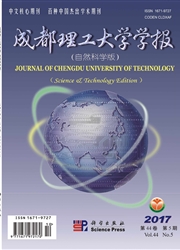

 中文摘要:
中文摘要:
重庆石柱下三叠统嘉陵江组发育上扬子地台碳酸盐台地上具代表性的岩石类型,以室外剖面测试和室内微相分析为主要手段,参考Wilson的标准微相和碳酸盐台地沉积模式,识别出8种微相类型:灰泥石灰岩;生物碎屑内碎屑泥粒灰岩;含生物碎屑泥灰岩;生物碎屑粒泥灰岩;生物碎屑泥粒灰岩;核形石、鲕粒、藻砂屑泥灰岩;生物扰动泥灰岩;有孔虫泥粒灰岩。八种微相类型在时空上的有序组合,构成了碳酸盐岩台地相区的三个亚相类型,即蒸发台地、局限台地和开阔台地。根据沉积相纵向和横向的变化,建立了沉积相模式,相对海平面的两个海进—海退旋回很好地控制了沉积相模式演化,为该区的区域性地质研究和油气勘探与开发提供重要的基础地质资料。
 英文摘要:
英文摘要:
The rocks developed in the Lower Triassic Jianglingjiang Formation in Shizhu of Chongqing represent the typical types in the carbonate platform of the upper part of the Yangtze platform. By measuring the profile in the field and analysing the microfacies indoor and according to the normal microfacies and carbonate platform model of Wilson (1975), eight types of microfacies are recognized. They are marlite; bioclastic-intraclastic packstone; bioclastic marl; bioclastic wackstone; bioclastic packstone; oncolith, ooid, alga calcarenite; bioclastic biodisturbed marlite; foraminifer packstone. The order combination of 8 types of microfacies in the study area composes three carbonate platform subfacies, that is, evaporate platform, restrctied platform and open platform subfacies. According to the longitudinal and transverse changes of the sedimentary facies, a sedimentary facies model is built. The evolvement of the sedimentary facies model is well controlled by two transgression-regression cycles with relative sea level changes. The research provides important and basic geological data for the regional geological research and oil and gas exploration and development.
 同期刊论文项目
同期刊论文项目
 同项目期刊论文
同项目期刊论文
 期刊信息
期刊信息
